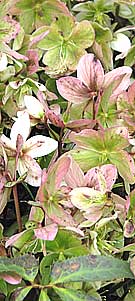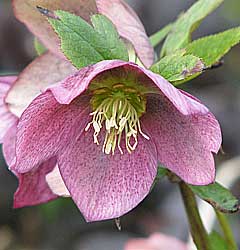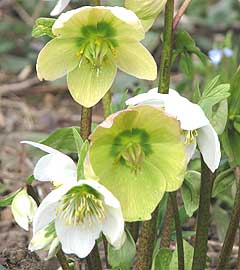Helleborus - How to grow the Christmas Rose
POPULAR VARIETIES OF HELLEBORUS
Helleborus Niger,
Helleborus Ivory Prince,
Helleborus argutifolius,
Helleborus white beauty,
Helleborus thibetanus

The Christmas Rose Legend
A young shepherd girl named Madelon was watching her sheep one cold winter's night.
As Madelon tended her sheep, a group of three wise men and several shepherds passed by her. The travellers were bearing gifts to take to the newly born Jesus.
Madelon cried - she had no presents to give to the baby Jesus - not even a simple flower....
An angel, who heard the shepherdess weeping, appeared before her and cleared away a small area of the snow and revealed a beautiful white flower blushed with pink - the Christmas Rose.
PLANT SOCIETIES
HELLEBORUS, CHRISTMAS ROSE, LENTEN ROSE
 Helleborus
are also known as Christmas Rose, Lenten Rose or Hellebores.
Helleborus
are also known as Christmas Rose, Lenten Rose or Hellebores.
Helleborus are a part of the Ranunculaceae family of plants.
The value of helleborus which can be hardy evergreen or leaf -losing perennials, lies in the fact that they provide welcome flowers during winter and early spring, and for that reason can claim a special place in the garden.
Helleborus plants grow from 18 to 24 inches high and have large, often glossy, leaves.
CHRISTMAS ROSES AND LENTEN ROSES
The Christmas Roses, Helleborus niger, of which the best and earliest is the white-flowered altifolius, bloom from December until March, and the Lenten Roses, Helleborus orientalis, flower from February to April.
A native of europe, the Christmas Rose grows 15 inches high and bears single white flowers which are about 3 inches in diameter. Helleborus Niger Altifolius and Helleborus Niger maximus are splendid varieties.
Lenten Roses, Helleborus Orientalis, are natives of Greece. The flowers of Lenten Roses are in purple, pink and grey, and the plants grow 12-18 inches high and flower from february to April.
Good varieties of Lenten Rose are Isolde, pale pink; Snowdrift, white; and Alcyone, blush pink.
WHERE TO GROW HELLEBORES
The Hellebores can be grown in a partly shaded border, or in pots in a cold greenhouse.
All types of hellebore prefer to grow in a sheltered position where they are protected from the effects of icy winds during winter and spring - these cold winds can cause damage to the emerging flower buds and leaves.
Hellebores grow best in a heavy neutral to alkaline soil with plenty of organic matter added.
Top up the soil with a mulch of organic compost in the spring and autumn.
PLANTING HELLEBORUS
 Hellebores
are planted 12 inches apart in March and April in moist, well-drained
soil, with which leaf-mould and decayed manure have been mixed.
Hellebores
are planted 12 inches apart in March and April in moist, well-drained
soil, with which leaf-mould and decayed manure have been mixed.
In April a soil mulch of equal parts rotted manure and leaf-mould should be given and the plants watered with liquid manure during April-May.
The blooms of the earliest types of hellebores should be protected from soil splashes in wet weather by means of a handlight, or moss, round the plants.
If plants are raised under glass they are potted separately in 6-inch or 8-inch pots in October, the pots filled with equal parts fibrous loam, leaf- mould and rotted manure, with a little coarse sand, then placed in a greenhouse or frame.
They are planted out in April after flowering, or the pots can be plunged in the ground in partial shade.
PROPAGATING HELLEBORUS
Plants are increased by lifting the old clumps in April and dividing them into pieces, each of which has four or five buds.
GROWING HELLEBORUS FROM SEED
Growing Hellebores from seed is a very slow method of propagation Helleborus seed can take 6 to 18 months, sometimes even longer, to germinate.
The best results with germination of seed are often obtained by sowing freshly harvested hellebore seed.
A hellebore plant grown from seed can take 3 years before it flowers.